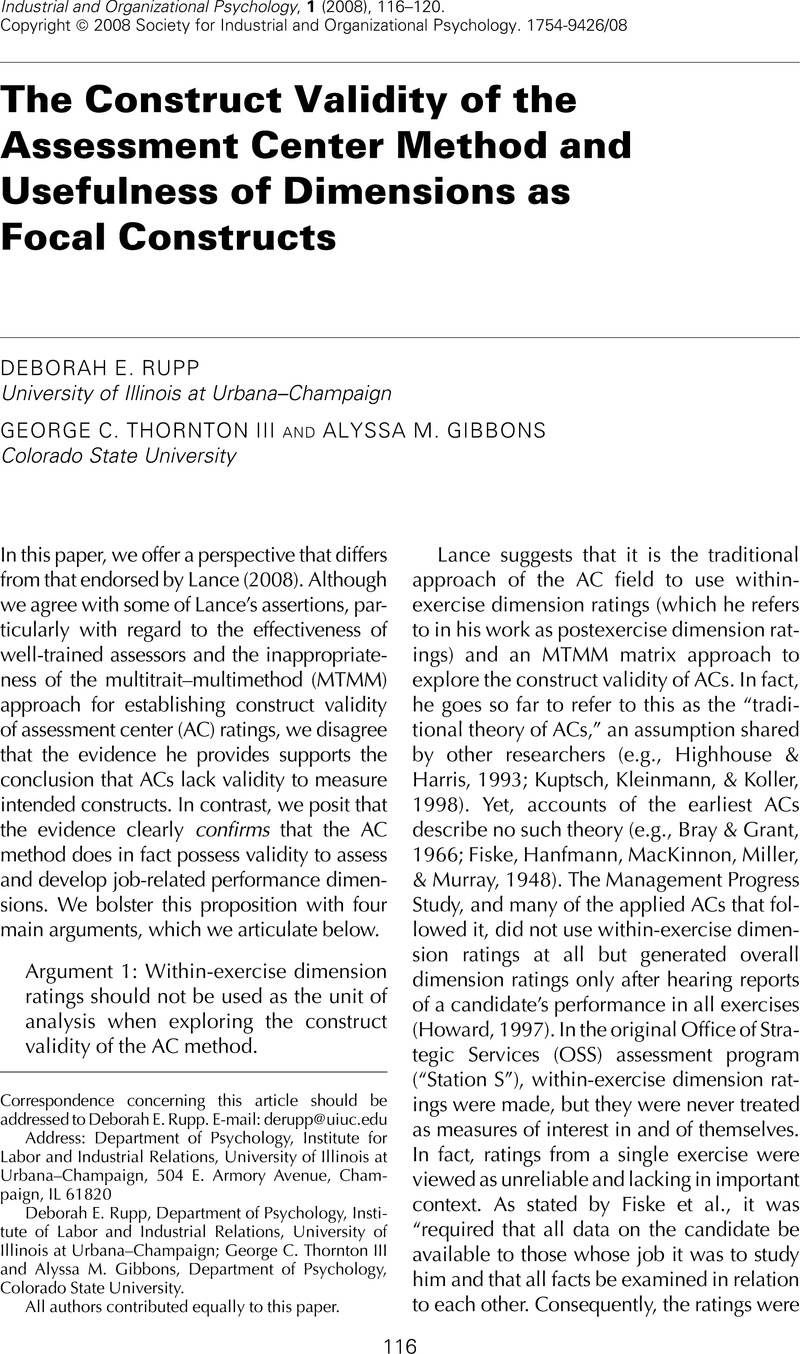Crossref Citations
This article has been cited by the following publications. This list is generated based on data provided by Crossref.
Lance, Charles E.
2008.
Where Have We Been, How Did We Get There, and Where Shall We Go?.
Industrial and Organizational Psychology,
Vol. 1,
Issue. 1,
p.
140.
2008.
Personnel Selection.
p.
310.
HOFFMAN, BRIAN J.
and
WOEHR, DAVID J.
2009.
DISENTANGLING THE MEANING OF MULTISOURCE PERFORMANCE RATING SOURCE AND DIMENSION FACTORS.
Personnel Psychology,
Vol. 62,
Issue. 4,
p.
735.
Thornton, George C.
and
Gibbons, Alyssa M.
2009.
Validity of assessment centers for personnel selection.
Human Resource Management Review,
Vol. 19,
Issue. 3,
p.
169.
BRUMMEL, BRADLEY J.
RUPP, DEBORAH E.
and
SPAIN, SETH M.
2009.
CONSTRUCTING PARALLEL SIMULATION EXERCISES FOR ASSESSMENT CENTERS AND OTHER FORMS OF BEHAVIORAL ASSESSMENT.
Personnel Psychology,
Vol. 62,
Issue. 1,
p.
137.
Gibbons, Alyssa Mitchell
and
Rupp, Deborah E.
2009.
Dimension Consistency as an Individual Difference: A New (Old) Perspective on the Assessment Center Construct Validity Debate.
Journal of Management,
Vol. 35,
Issue. 5,
p.
1154.
Lievens, Filip
Dilchert, Stephan
and
Ones, Deniz S.
2009.
The Importance of Exercise and Dimension Factors in Assessment Centers: Simultaneous Examinations of Construct-Related and Criterion-Related Validity.
Human Performance,
Vol. 22,
Issue. 5,
p.
375.
Jackson, Duncan J. R.
Stillman, Jennifer A.
and
Englert, Paul
2010.
Task‐Based Assessment Centers: Empirical support for a systems model.
International Journal of Selection and Assessment,
Vol. 18,
Issue. 2,
p.
141.
DRAGONI, LISA
OH, IN‐SUE
VANKATWYK, PAUL
and
TESLUK, PAUL E.
2011.
DEVELOPING EXECUTIVE LEADERS: THE RELATIVE CONTRIBUTION OF COGNITIVE ABILITY, PERSONALITY, AND THE ACCUMULATION OF WORK EXPERIENCE IN PREDICTING STRATEGIC THINKING COMPETENCY.
Personnel Psychology,
Vol. 64,
Issue. 4,
p.
829.
Silzer, Rob
and
Jeanneret, Richard
2011.
Individual Psychological Assessment: A Practice and Science in Search of Common Ground.
Industrial and Organizational Psychology,
Vol. 4,
Issue. 3,
p.
270.
Hoffman, Brian J.
and
Meade, Adam
2012.
Alternate Approaches to Understanding the Psychometric Properties of Assessment Centers: An analysis of the structure and equivalence of exercise ratings.
International Journal of Selection and Assessment,
Vol. 20,
Issue. 1,
p.
82.
Monahan, Elizabeth L.
Hoffman, Brian J.
Lance, Charles E.
Jackson, Duncan J. R.
and
Foster, Mark R.
2013.
Now You See Them, Now You Do Not: The Influence of Indicator–Factor Ratio on Support for Assessment Center Dimensions.
Personnel Psychology,
Vol. 66,
Issue. 4,
p.
1009.
Brits, Nadia M.
Meiring, Deon
and
Becker, Jürgen R.
2013.
Investigating the construct validity of a development assessment centre.
SA Journal of Industrial Psychology,
Vol. 39,
Issue. 1,
Bishopp, Stephen A.
2013.
An evaluation of the promotional processes in a large Texas metropolitan police department.
Policing: An International Journal of Police Strategies & Management,
Vol. 36,
Issue. 1,
p.
51.
Guenole, Nigel
Chernyshenko, Oleksandr S.
Stark, Stephen
Cockerill, Tony
and
Drasgow, Fritz
2013.
More than a mirage: A large‐scale assessment centre with more dimension variance than exercise variance.
Journal of Occupational and Organizational Psychology,
Vol. 86,
Issue. 1,
p.
5.
Meriac, John P.
Hoffman, Brian J.
and
Woehr, David J.
2014.
A Conceptual and Empirical Review of the Structure of Assessment Center Dimensions.
Journal of Management,
Vol. 40,
Issue. 5,
p.
1269.
Condomines, Bérangère
Hennequin, Émilie
Borteyrou, Xavier
Mazouz, Bachir
Rousseau, Anne
and
Sponem, Samuel
2015.
Détection des compétences managériales.
Revue Française de Gestion,
Vol. 41,
Issue. 251,
p.
49.
Бородієнко, Олександра
2018.
ВИКОРИСТАННЯ ТЕХНОЛОГІЇ АСЕСМЕНТ-ЦЕНТРІВ ДЛЯ ДІАГНОСТУВАННЯ РІВНІВ РОЗВИНЕНОСТІ ПРОФЕСІЙНОЇ КОМПЕТЕНТНОСТІ КЕРІВНИКІВ СТРУКТУРНИХ ПІДРОЗДІЛІВ ПІДПРИЄМСТВ СФЕРИ ЗВ'ЯЗКУ.
Науковий вісник Інституту професійно-технічної освіти НАПН України. Професійна педагогіка,
p.
61.
Buckett, Anne
Becker, Jürgen Reiner
Melchers, Klaus G.
and
Roodt, Gert
2020.
How Different Indicator-Dimension Ratios in Assessment Center Ratings Affect Evidence for Dimension Factors.
Frontiers in Psychology,
Vol. 11,
Issue. ,
Wirz, Andreja
Melchers, Klaus G.
Kleinmann, Martin
Lievens, Filip
Annen, Hubert
Blum, Urs
and
Ingold, Pia V.
2020.
Do overall dimension ratings from assessment centres show external construct-related validity?.
European Journal of Work and Organizational Psychology,
Vol. 29,
Issue. 3,
p.
405.





